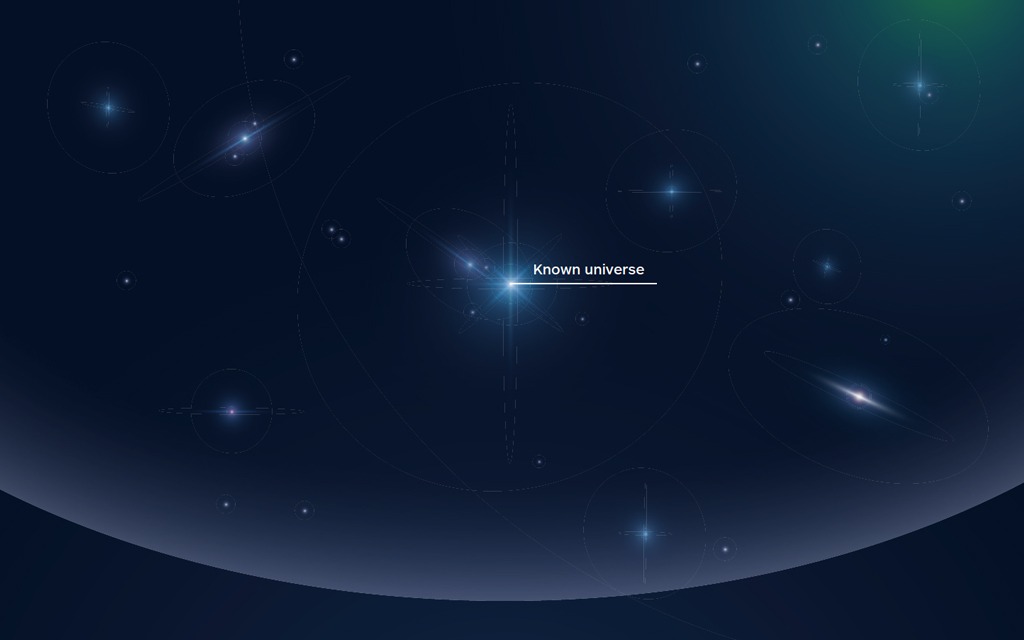Technology
What is the thread that connects us with what we do not yet know? Ersilia Vaudo discusses the intrinsic language of the universe: mathematics.
The future is not necessarily unknown. We clearly don’t know if the Universe will continue to expand forever or if there will be a crunch one day. Yet there exists an inevitable, deterministic future precisely established by the laws of physics. All this projects an enthralling narrative; an example. ESA’s Gaia mission, which has provided the most accurate and multi-dimensional mapping of two billion stars in the Milky Way, has revealed their precise position and velocity. We can use the data to anticipate what the skies will be like for the next 1.6 million years. But it also tells us that our galaxy is cannibalizing the dwarf galaxy Sagittarius. And perhaps our Sun was born from one of the associated collision events. Past events and future scenarios clearly emerge from the starry maze of the night skies.
There are other things we know. One of the proofs of the expansion of the Universe is the redshift of the light emitted by the galaxies, an unmistakable sign of receding bodies. Yet, the light spectrum of Andromeda, our neighbor galaxy, is shifted towards blue: fast and relentless, it is heading towards us. We already know the outcome. In about 4.5 billion years, Andromeda and the Milky Way will entwine in an awesome embrace, as a silent clash in a Universe that knows no sound. We will hardly witness it, as the Sun will burn out around that time. Our star will tremendously expand, swallowing Mercury, Venus and possibly the Earth, and then collapse into a dense, almost invisible white dwarf.
The fact that the speed of light cannot propagate simultaneously but must travel from an arbitrary point in the Universe to reach our eyes implies a magical effect: peering far into distant space is akin to observing the past. This affords us a sort of superpower, as the past is laid out before us.
Thanks to the James Webb Space Telescope, the most powerful telescope ever built, we can look so far back in time that we can see the earliest galaxies, which emerged some 13.4 billion years ago when the Universe was little more than a newborn reality. With its instruments capable of discriminating infrared wavelengths – associated with light from the most distant origins – the James Webb has carried out a spectacular Deep Field scan, one of the most accurate and far-seeing images of the Universe, containing thousands of beautiful galaxies.
Overlaps, layers of time and many generations of galaxies, all in a single image. However, no telescope will ever be able to tell us what happened close to the big bang. Because light itself was born much later, about 380,000 years after that beginning, and we can still observe those very first photons, the first light that ever existed, an image of the remotest possible reality. What happened before may soon be revealed to us by gravitational waves, shivers of space-time that propagate at the speed of light. It is extraordinary to realize that all we can observe of the Universe, with its 200 billion galaxies, is only 5% of what the Universe contains. We can interpret the rest through gravity: 20% is probably dark matter which, among other things, stabilizes the rotation of galaxies. But there is also a formidable 75% likely consisting of a mysterious dark energy that permeates the fibers of space-time and accelerates its expansion.
Because of this expansion, at some point in the future, the distance between galaxies will be such that the sky will be nothing but darkness.
Indeed. The frame of reference with which we interpret reality is anything but self-evident. It is enmeshed in preconceptions and beliefs; it morphs through science and is sedimented in language. In Western culture, the future is almost always ahead: a forward direction that defines the trajectory of time.
It is extraordinary to think that everything we can observe in the universe, with its 200 billion galaxies, is only 5% of what the universe contains.

The illustration was created with the proportions described:
the gradient area represents the whole universe, and the known universe, which is the 5%, takes up 5% of the area itself.
It is not so everywhere. The Aymara, an indigenous people of the Andes, believe that the past lies ahead of us because it is known and can take on meaning and form. Instead the future, which we do not know and cannot see, remains behind us. It was the same for the ancient Greeks. The English language has also retained a vestige of this idea: ‘before’ is used for both what happened previously and what lies in front of us.
Mathematics is the thread that connects us with what we do not yet know about the unknown.
But how can we address all this without losing the richness of linguistic and cultural diversity, while still managing to work together and communicate? At ESA, we have engendered a multilingual collective intelligence. Sometimes we wonder what language we should use to speak. In the past, behind some open doors, you could hear eccentric engineers conversing in Latin.
But space and the Universe have an intrinsic language of their own: mathematics.

World Wide Wisdom
Research Report 2023
It is possibile to improve the understanding between people that speak different languages and thus improve their ability to do things together in a smarter way? Can it be that a multilingual group is able to do better things? In order to answer to these questions we need to take into account how groups of people think and work together and how their collaboration can be improved.
Get Your Copy Now!Mathematics is the thread that connects us with what we do not yet know about the unknown. It has conveyed unimagined realities to us before we could ever conceive of them. For example, in his theory of general relativity, Albert Einstein devised equations that suggested a dynamic, expanding Universe. He considered this an absurd hypothesis and contrived to add a “cosmological constant” to counteract the expansion and restore a static, unchanging Universe. Only 13 years after, the expansion of the Universe was proven to be true. Several years later, Paul Adrien Maurice Dirac solved an equation that has two solutions, one with a positive sign related to an electron and an equal and opposite one with a negative sign. An anti-electron? Impossible? Three years later, Paul Anderson reported his observations of antimatter. Mathematics is the language of the Universe that disregards our awareness or interpretations of it. But then, it is also the language of humanity itself, the language of interculturality. In the Golden Record stowed on Voyager on its journey through interstellar space in the hopes of one day ending up in the hands of extraterrestrial civilizations, there is a great deal of mathematics. In his book Contact, Carl Sagan, chairman of the Golden Record content selection committee, emphasizes that an intelligent civilization will certainly have posed itself the problem of a circumference: In any galaxy you find yourself, you take the circumference of a circle and divide it by its diameter. Could this perhaps be the symbol of a universal language? The extraordinary, mysterious Pi.

Ersilia Vaudo
Space, STEM, European Space Agency, Presidente Il Cielo Itinerante
Ersilia Vaudo Scarpetta graduated from the Sapienza University of Rome with a degree in Astrophysics. For many years, she has been working for the European Space Agency, where she now holds the position of Chief Diversity Officer and Special Advisor on Strategic Evolution. Her professional journey has also taken her to Washington, where she spent 4 years managing ESA relations with NASA. She has received numerous accolades, including the Tecnovisionarie 2020 International Prize. In 2021, she was included in the InspiringFifty list, which recognizes the 50 most influential women in the field of science and technology in Italy. In 2022, she curated the 23rd International Exhibition of Triennale Milano, titled Unknown Unknowns. She is the president and co-founder of the association Il Cielo Itinerante (The Wandering Sky), which promotes STEM literacy by “taking the sky where it doesn’t reach”, to boys and girls in troubled areas affected by educational poverty.
Photo credit: Deepmind, Unsplash
